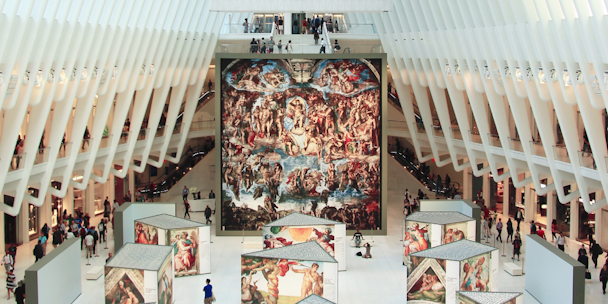What’s to come from Instagram museums?
If future archaeologists were to dig up remnants of present-day America, they would likely conclude that our civilization worshipped food and drinks as deities. Their evidence: the culinary-themed museums proliferating around the country.

Rachel Saunders of We're Magnetic discusses the future of instagram-friendly pop-up exhibits / Robin Garnier via Unsplash
What began in 2016 with the Museum of Ice Cream has become a full-fledged cultural trend that has others hustling to reengineer the popularity of the original. In the coming months, NYC will be home to the Museum of Pizza, Rosé Mansion, and two sugar-themed spectacles: the Museum of Candy and Candytopia. San Diego will host a museum dedicated to toast’s favorite topping, and Los Angeles will be home to Cheat Day Land—a playground that encourages the health conscious to surrender to the joys of gluten.
Surrendering they are, and not just to food museums. Similar pop-ups based on color and joy are commanding $28 to $38 per ticket for what amounts to about an hour of uncomplicated indulgence in an environment optimized for Instagram—a commercial take on immersive art exhibits, like those of Yayoi Kusama. Given the organic shares these spaces are inspiring from the public, marketers have been eager to build shareworthy experiences of their own or create their version of Refinery29’s 29Rooms. Before going that route, there are three things they should consider.
Offer a story, not a set.
29Rooms is effective because it connects the experience to Refinery29's larger brand identity. It offers fodder for Instagram, but it also provides a relevant narrative that creates a more emotional connection between the consumer and the brand. Imitators often lack a narrative or wedge one in as an afterthought, which isn’t a shrewd move given that 86% of consumers say authenticity is important to them when deciding what brands they like and support.
Offering a visually compelling set and little else works when selling a ticket to someone who wants a photo opp. It’s not a strategic decision for a brand that wants to build a relationship with its audience and earn their repeat business. Young generations prefer to buy from brands whose values align with their own, and they won’t know what those values are if all that’s being offered is an Instagram backdrop.
Approach consumers as creators.
Creativity is a quality that young generations put on a pedestal—especially Generation Z. They’ve had access to tools for capturing, editing, and mixing content for much of their lives, and they like to think of themselves as creators rather than consumers. Brands can appeal to them as auteurs, not amateurs, by offering interactive experiences that let them interpret the environment through their own lens, rather than build sets that encourage the same shots and actions. Brands can also appeal to the creator mindset by offering a glimpse of their own artistic approach.
The Museum of Ice Cream took this approach for its NYC retail concept, the Pint Shop, by offering hands-on tasting sessions that explore the origins of its vanilla ice cream. Jaguar Land Rover, Shell, Teen Vogue, and others are going even deeper, launching summits for the public that immerse people in their brand’s values and leave them with tools to leverage in their own creative or professional pursuits. They build a relationship with consumers that’s more akin to a VC and startup, which sends a message that the brand is invested in their success, not just trying to sell them something.
Prioritize video and audio.
Marketers are under pressure to measure ROI on experiences, and social media impressions—while only one piece of a more holistic puzzle—are often cited when evaluating success. Yet many made-for-social experiences are being constructed with still photos in mind when consumers are increasingly incorporating other forms of sharing. Instagram Stories are growing 15x faster than feeds and are on track to become users’ preferred method of sharing content.
Audio is likewise gaining momentum in its own right. Given these shifts, building static sets is not only less compelling from a creative standpoint, it’s less in sync with sharing styles.
Marketing trends like Instagram museums will have to evolve if they want to stand the test of time. The good news? The human need to connect and convene has staying power. The brands that build better shared experiences, not just shareable experiences, will as well.
Rachel Saunders is global director of consumer research & insights at We’re Magnetic
